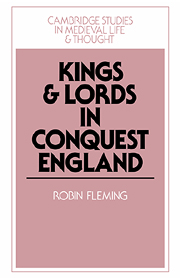Book contents
- Frontmatter
- Contents
- List of figures
- List of tables
- Preface
- List of abbreviations
- PART I CNUT'S CONQUEST
- PART II THE NORMAN CONQUEST
- 4 Domesday Book and the tenurial revolution
- 5 Territories and time
- 6 Private enterprise and the Norman settlement
- 7 Aristocratic landholding and royal power in the eleventh century
- Bibliography
- Index
5 - Territories and time
Published online by Cambridge University Press: 09 October 2009
- Frontmatter
- Contents
- List of figures
- List of tables
- Preface
- List of abbreviations
- PART I CNUT'S CONQUEST
- PART II THE NORMAN CONQUEST
- 4 Domesday Book and the tenurial revolution
- 5 Territories and time
- 6 Private enterprise and the Norman settlement
- 7 Aristocratic landholding and royal power in the eleventh century
- Bibliography
- Index
Summary
The widespread destruction of Old English lordships and kindreds altered the tenurial fabric of England. This metamorphosis of aristocratic landholding was not limited to the counties and vills described in the previous chapter: it was evident throughout the kingdom. In the marches the changes were dramatic. Shropshire, southern Lancashire, and Cheshire, protecting the kingdom's western flank from Welshmen and Norse Irish, and from Anglo-Saxons exiled in Ireland, were reorganized soon after 1066 along new, Continental lines. In Shropshire there was an almost complete abandonment of ancient tenurial, familial and lordship patterns in favour of endowments constructed from consolidated stretches of territory. By the time of the Domesday inquest nearly all the land found in this county's secular fees was listed under the rubric of Roger de Montgomery regardless of Anglo-Saxon antecessors, and his Shropshire honour in no way mirrored tenurial patterns in existence before the Conquest. Ralph de Mortimer's fee in the county was built around his castlery of Wigmore and Osbern fitz Richard's abutted Richard's Castle. Neither can be described as the fossil of an earlier lordship and, furthermore, the compact territories of these two tenants-in-chief could be found in 1086 straddling the Shropshire–Herefordshire border, a boundary which a generation earlier had separated the Mercian and West Saxon earldoms.
- Type
- Chapter
- Information
- Kings and Lords in Conquest England , pp. 145 - 182Publisher: Cambridge University PressPrint publication year: 1991



